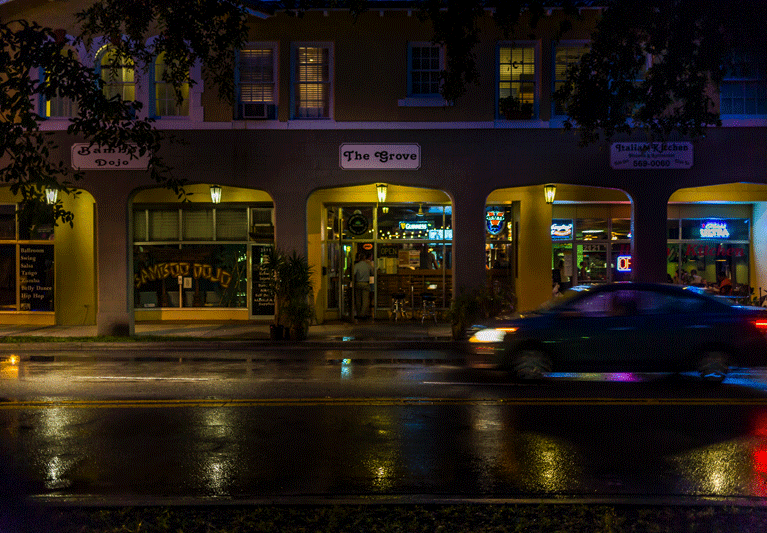
A man was shot multiple times in front of a crowd of witnesses on the main drag in downtown Vero Beach and, six months later, no one has been arrested.
How can that happen?
It’s bad enough that such a violent crime would occur in so public a setting in the heart of our small-town community. But for so much time to pass without the shooter being apprehended?
Shouldn’t someone have been locked up a long time ago?
How is it possible that with so many eyes observing the incident, when Andy Capak, co-owner of The Grove Bar, was gunned down shortly before 2 a.m. on March 31, no arrest has been made?
Well, police continue to counsel patience.
“We believe we know who did it, and that was from Day 1 for the most part,” Vero Beach Police Chief David Currey said last week. “We have the same person in mind now that we had six months ago.”
“We want to solve this case, but our investigation is driven by leads to follow up, not some arbitrary schedule,” Currey said. “I wish we had made an arrest that night, or the next day, or a month later. But you just can’t put a time on it.
“We followed up with someone on our checklist as recently as a week ago,” he continued.
“As long as we’re following up, we’re not done.
“You can’t let external things drive your case. We’ve still got a couple of things we’re working on, and we’re moving toward an end.
“That doesn’t mean we’ll make an arrest next week,” he added, “but we think we’ve done a thorough job.”
For the record: I’m not blaming the police, who, in large part, are merely playing the bad hand that they were dealt.
I have no doubt Currey and his detectives want to solve this case.
They don’t want anyone to think it is possible they can shoot someone in front of multiple witnesses in Vero Beach and get away with it. They know the public is watching and that this story isn’t going away.
True, there are some nagging questions about confused interactions that night between 911 callers, the 911 operator and police officers on the scene – communications lapses that might’ve allowed the shooter to make a clean getaway.
Currey, though, denied the botched communications between the 911 operator and his officers, saying, “We were on the scene in seconds.”
That aside, the more troubling problem for detectives are the statements taken from witnesses who, apparently, offered differing accounts and descriptions of the shooter.
Those conflicting statements, as much as anything, have prevented police from making an arrest. And for good reason: Detectives, working closely with Assistant State Attorney Bill Long, want to make sure they have a can’t-lose case before charging someone with the crime.
That makes sense – the last thing anyone should want is for police to arrest the shooter, only for some defense attorney to use conflicting testimony from witnesses to convince a jury to bring back a not-guilty verdict.
And, according to Currey, there are some significant discrepancies.
“You have to look at all your statements,” Currey said. “We have multiple witnesses, so we have multiple statements. You’re hoping things match up, and when they don’t, it makes it difficult.”
Apparently, witnesses provided different descriptions of the shooter – which isn’t surprising, given the late hour and the fact that the shooting occurred outside a bar.
As someone who is married to an ex-prosecutor and former assistant public defender, I can’t tell you how many stories I’ve heard about the unreliability of eyewitness testimony.
I can tell you, however, that these discrepancies in the witness statements are a problem, especially since there’s a real chance some of those giving their versions of what happened were (hard as it is to believe) under the influence of alcohol at the time.
“That’s why we continue to work on things,” Currey said, adding that he’s reluctant to share too much information about the case because police believe the suspect still resides in the area and “the bad guys could be listening, too.”
Currey did say police do not have any smartphone video of the shooting – something that also would’ve been helpful.
As for Capak, 31 at the time, who was shot four times but survived, Currey said the 2003 St. Edward’s School graduate has cooperated with the investigation.
Asked when the victim was able to identify the shooter, the chief declined to answer.
However, in an interview in June, Capak’s sister, Janet, said her brother didn’t remember much about the incident and she wasn’t sure how much help he was able to offer police.
“He remembers the gun going off,” she told me then. “He said it felt like he was shot with a blank, because he was still standing. He thinks that’s why the guy shot three more times – because he didn’t go down after the first one.”
She said her brother’s memory of the shooter wasn’t clear, “even though he was looking straight at the guy.”
She said her brother recalled seeing the shooter and his companions in the bar and actually remembered what they ordered, but once he began to try to break up the fight, his mind became fuzzy.
Capak, who refused to be interviewed in June, could not be reached for comment last week.
Currey, meanwhile, said he and his detectives will meet with Long this week to assess the status of the case.
“I do think we’re coming close, finally, but there are still one or two loose ends that still need to be tied up,” Currey said.
“We’re being methodical, thorough and patient because we want to get this right. That’s what everyone should expect from us.”
That’s how something like this can happen – even in Vero Beach.



